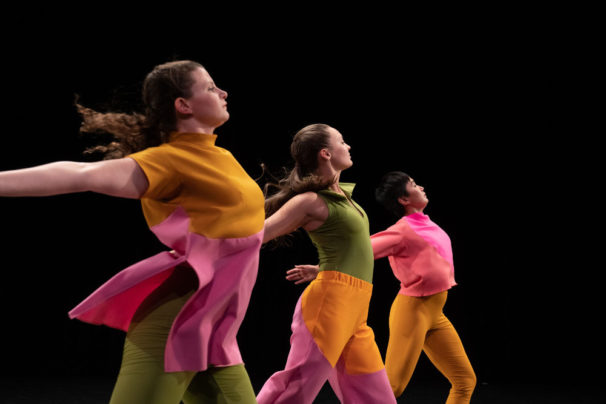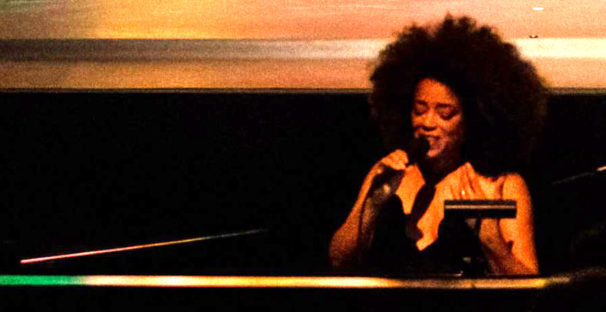
The tenderness, the tenacity, the yearning, and the joy burnished in the lilting melodies composed by Burt Bacharach, so perfectly paired with the high-flown romance of Hal David‘s lyrics, formed the basis for “The Look of Love,” a new hour-long dance work that had its world premiere this weekend at the Broad Stage in Santa Monica. The work is of great interest as it is one of the most ambitious original dance programs created by as important a choreographer as Mark Morris since the pandemic. And Mr. Bacharach, now in his nineties, merits appreciation. The much-treasured songs, dating from the ’60s and ’70s, Mr. Morris personally curated as a packaged song-compendium for the Mark Morris Dance Group. The performance lifted the Broad Stage house because … hey, who does not love that music?
Unfortunately for dance fans, the closest expression of the steep emotional arcs embedded in every Bacharach/David song happened not on stage delivered by dancers, but in the orchestra pit where a gracious chanteuse, Marcy Harriell, joined by two very fine backup singers (“dooby dooby dah ah ah ah,” they sang at one point) led the audience through the fourteen-song roster — the dancers didn’t.
For, in Mr. Morris’s uninspiring spiel of choreography, the dancers failed to grasp the essence of Bacharach — the light aural touch crossed with deep, roiling emotion. But the singer, Ms. Harriell, without budging from her spot, her lovely face framed by a ginormous soft Afro, packed in all the expressiveness, particularly the tenderness, that the songs warrant. Mr. Morris, such an admirable craftsman who is so devoted to working in form, just seemed stymied by the call to emotion.

Never loosening his grip, he dispatched his cadre of dancers through their paces, and by paces we mean literal pacing. They march, they trot, they file, they form a circle, they do a daisy-chain. They do triplets and waltz steps; they kick up a single leg accompanied by the raise of an arm; they do a balletic renversé into a back attitude turn; they do handstands that have no drama nor shape. They bring chairs on stage, then remove them. They dance on the chairs (and the chairs, with design credited to Isaac Mizrahi, squeaked). That, by and large, is “The Look of Love,” rinse-and-repeat. The end product was so repetitive, and, really bloodless, that one wonders if Mr. Morris was stretched beyond capacity.

Mr. Morris had his Group illustrate Hal David’s lyrics: windmilling arms, airplane arms, body in the shape of a train, fists beating on chest, give your torso a little self-hug — each motif triggered by a lyric. They look skyward in “Raindrops Keep Falling on my Head.” Really?? This reductive approach to the songs was a road to nowhere.
Morris’s prior “compendium” offering, staged to the Beatles “Sgt Pepper,” I thought, was a triumph. Sgt Pepper, which bears the English music hall tradition of oom-pah-pah thudding beat, fits well with Mr. Morris’s movement, which, truth be told, overworks the on-beat. Bacharach, by contrast, is not a rhythm man. He’s a melody maker. And he spins melodies so gossamer, so high reaching, so filigree and soaring, that only their tinge of sadness gives them weight. The songs invite you to take a ride. (Frankly, I think pointe shoes and velocity should be involved.)
Burt Bacharach’s “Anyone Who Had a Heart,” a song so magisterial that the likes of Luthor Vandross, Linda Ronstadt, of course Dionne Warwick (don’t forget Dusty Springfield) recorded it, is a throw down of emotionalism, it’s a pulsating heart attack of a song. It’s a soap opera. Mr. Morris’s work in it was more of the same. Bacharach’s call to emotion he ducked. A personal favorite, “Message to Michael,” a song of great mystery, had one dancer mouthing the words as a karaoke performer. A fussy duet spooled in the foreground.
I enjoyed Ethan Iverson’s robust new song arrangements — inventive, playful, delicious. The dancers I found more dutiful than sensational. It’s hard to know what they could do if Morris let them off-leash. A very fine one, Billy Smith, Mr. Morris featured at center stage, and with good reason. His approach came closest to the feathery frolic I was hoping for. He also had the best Isaac Mizrahi costume, a yellow block-designed tunic and yellow tights.
It may be something in the air. Morris made his Bacharach dances in Brooklyn. That’s the opposite of the sensory environment that gave birth to Bacharach’s cool, very-California sound — think car driving up the PCH, think dark, nippy air wafting a blend of blossoms and salty sea smell; hear the sound of crashing surf. I don’t suggest that Morris speak in a voice not his own. But the voice spoken in “The Look of Love,” for me, much missed its mark.
